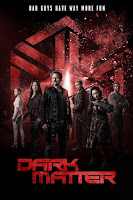In this series of posts, I’m discussing science fiction and fantasy television I’ve watched recently. There are far too many interesting shows out there for me to keep up, so I tend to have some time lag in the ones I’m watching. Today, I want to talk about two shows that have just gotten started via their first season, and two that have been canceled. I have linked where the shows can be watched online.
Starting Shows
Mars (National Geographic Channel, Season 1): This one is a half-drama/half-documentary about the colonization of Mars. On the documentary side, there’s a lot of neat information on the recent history of space programs. For instance, I enjoyed seeing interviews with people involved in SpaceX and the efforts to make reusable rockets. The drama side was sometimes a little dry, but also an interesting exploration of what it might be like for humanity to attempt to build a sustainable habitat on Mars. The planned second season will jump forward in time, to follow the imagined future development of the Mars colony.
The Gifted (Fox, Season 1, free to view): I am a big fan of the X-Men, so I had high hopes for this show. So far, it appears to be the X-Men show I always wanted. In this future, the Brotherhood and the X-Men have vanished, and the government has cracked down on mutants. The viewer is introduced to the world through the Strucker family, who have been privileged enough to never have to care about the ethics of their government’s policies about mutants. This all changes when the two Strucker children display mutant abilities. The Struckers join the mutant underground, a group struggling to help mutants survive (or, according to the government, a “terrorist group”). The show has an excellent ensemble cast, the special effects are well done, and the writers seem to be very aware of the political environment in which their show will be viewed. I’m looking forward to the second season of this one, and it was my favorite show of the winter.
Ending Shows
Dark Matter (Syfy, Season 3, also available to stream on Netflix): Dark Matter is the story of a crew that woke up one day on their spaceship with no memories. They reforged bonds with one another and reconstructed their identities, even as they sought to learn who they were before. The show has been canceled after its third season, and finale doesn’t provide much in the way of a conclusion. I enjoyed watching the show, though its story never quite seemed to find solid footing. The characters felt stronger after the backstory episodes of season two, but the overall plot still lacked a throughline. Is it about a corporate war? Is it about an alien invasion? Is it about the definition of consciousness? Is it about a Japanese empire’s succession? It’s about all of these things and more, changing from one moment to the next. Each short story was pretty interesting, but they never seemed to come together into a coherent whole. Still, I’m sad that we won’t get to see this one through to a conclusion.
Extinct (BYUtv, Season 1, free to view): Extinct was a science fiction show from Brigham Young TV, but it does not appear to be explicitly Mormon. The show takes place hundreds of years after the human race was wiped out during an alien invasion. A mysterious benefactor has recorded the biological and mental forms of a collection of humans, and it is recreating them to revive human civilization. Three people--Ezra, Abram and Feena--are awakened to find an emptied settlement and a tribe of humans controlled by alien parasites. They must put the pieces together to find out what has happened to humans who were awakened before them. I enjoyed how the mystery is slowly revealed over the course of the season, and how the characters are slowly built up through flashbacks to the invasion and their current choices. This show was canceled after a single season, but I would say that the it provides a story with a satisfying conclusion.





